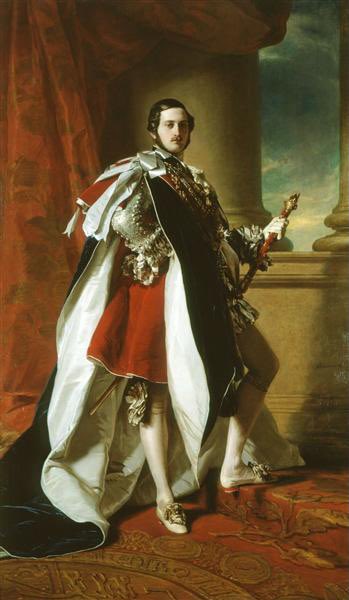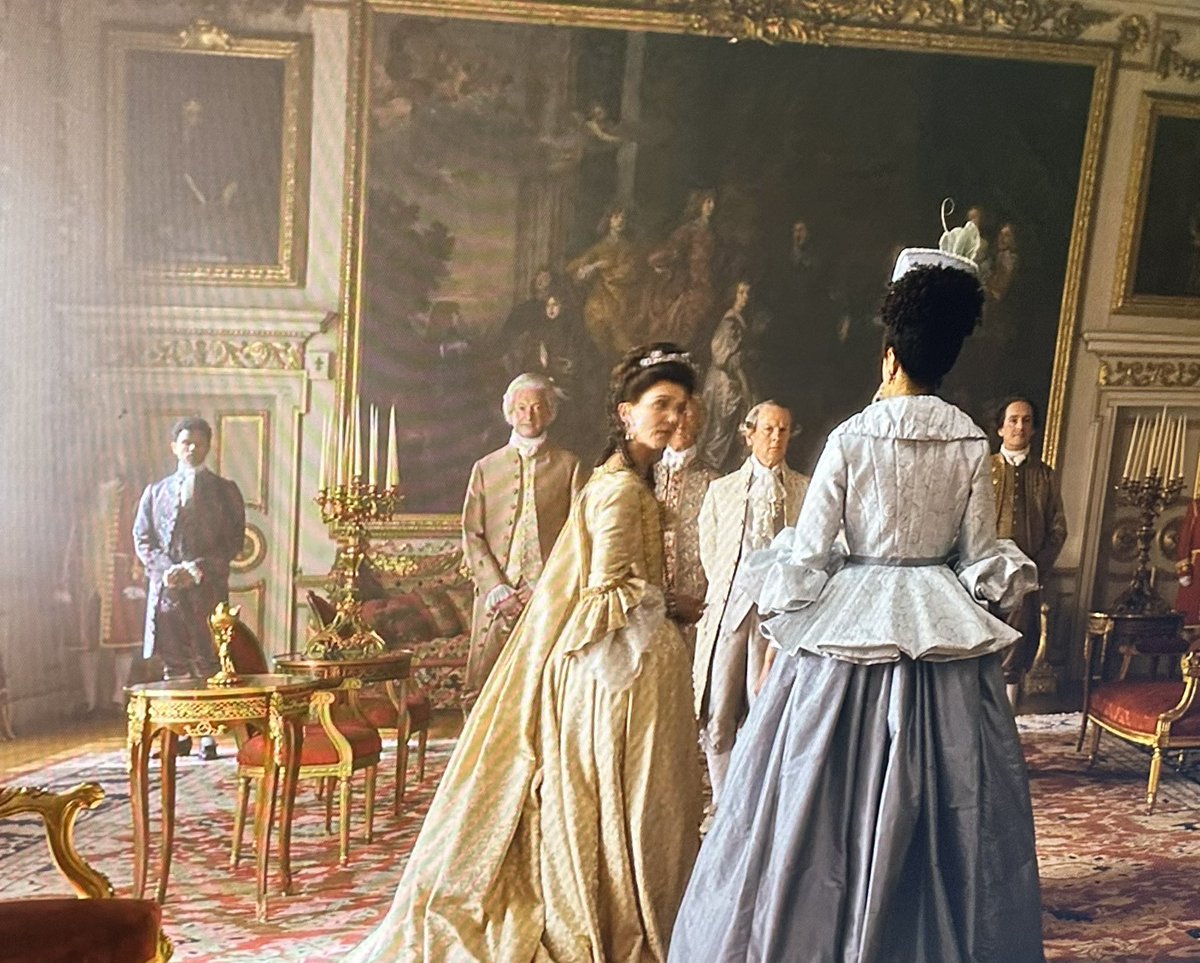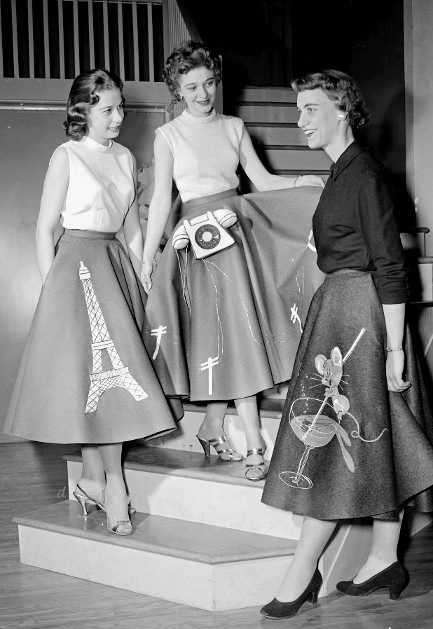These two are adorable, but the portraits in #QueenCharlotte are KILLING me. NONE of those people were even *born* in 1761! 

That is QUEEN VICTORIA. Specifically, her coronation portrait by Sir George Hayter. Her coronation was in 1838, 20 years after Charlotte DIED. 



And that’s her husband, Prince Albert, painted in the robes of the Order of the Garter by Frank Xaver Winterhalter in 1843. 



This is Victoria’s predecessor Queen Adelaide, wife of William IV, Charlotte’s third son. They married a few months before Charlotte’s death but this wasn’t painted until 1836, by Sir Martin Archer. I *hate* portraits from the future. 



This? Is a straight up photograph. It doesn’t look especially Georgian-it reminds me of a modern photo of the royal family as much as a Georgian portrait. 





These are a bit more reminiscent of the portraits George III commissioned of his steadily growing family. 







And this is a composite of Allan Ramsay’s coronation portraits of George and Charlotte, though they have been aged dramatically. George has white hair rather than a powdered wig, and Charlotte has giant late 1770s hair (which, in the Bridgerton multiverse, she keeps for decades). 





Here’s some real, period-appropriate art: the massive Van Dyck at Wilton House and the King’s Staircase at Hampton Court, both used as locations in Bridgerton, as well. 



This outfit baffled me at first. It has a jeweled stomached (Charlotte owned a diamond stomacher) and it’s described as being lacy and fragile—but it looks like a Brunswick or a riding habit, a casual, comfortable jacket and skirt popular for traveling, often worn with a tricorn. 







This outfit sums up so many of the problems with #QueenCharlotte and historical costuming in general. Beyond the corset discourse, it's a mashup of things we know the queen wore: the purple jacket or overgown (likely with a hood rather than a shawl collar) AND a blingy stomacher.
But she’d never wear them TOGETHER. It’s as if Rihanna threw on her yellow Guo Pei Met Gala cape over Fenty track pants. Both are distinctly, iconically Rihanna, but they belong to completely different contexts. 



Bridgerton/Queen Charlotte is not documentary, or even costume drama. It’s historical alternative universe, and that’s really interesting! But an AU will be MORE interesting and convincing if it’s anchored in real history and follows an internal logic, thematically and visually.
As I’ve said before, though, costuming and history are different beasts, and that’s OK! I’m sad that tired corset myths and misinformation are being perpetuated here, but nitpicking individual costumes is not very useful or interesting to non-academics. Fake portraits, however…
For all of you calling me a racist and a Karen, let me apologize for not making clear up front that I’m *huge* fan of both Bridgerton and Queen Charlotte and their crazy hot and talented multiracial casts (see my pinned Tweet). I am definitely side-eyeing Netflix here though….
There was SO much love and attention showered on the art direction and custom artwork for 2 whole seasons of Bridgerton—centered on a white family—that just isn’t being repeated here. I don’t know if it’s deliberate or malicious, but it’s disappointing. Charlotte deserves better!
I'm tempted to delete this whole thread, because I don't want to yuck anyone's yum--and because it's a lot more fun to talk about why good fake portraits are good than why bad ones are bad. But now I'm invested in the reasons why George is acting so sketchy, so on to episode 2!
Now this is more like it! Obviously, I *love* a getting-dressed montage or three, and there’s some nice French art in Charlotte’s boudoir: Fragonard’s Woman with a Dog (c. 1769, but nice foreshadowing) and Nattier’s Mme. Marsollier and her Daughter, both in the Met Museum. 







The Nattier is a toilette (getting-dressed) portrait, and there’s a famous 1764 toilette portrait of Charlotte herself by Zoffany which is visually quoted in this scene. Check out her silver gilt toilette set and lace table cover, bought in 1762 for 1,079 pounds and 14 shillings. 







Lucky Charlotte dines amid the trompe l’oeil baroque splendor of the Saloon at Blenheim Palace, the walls painted by Louis Laguerre around 1720. Blenheim was later the birthplace of William Churchill and is now a UNESCO World Heritage Site. 



Y’all. I really do want this show to be good, but this is literally the family photo of Charlotte, George, and all their GROWN CHILDREN from episode 1. She is looking at a portrait from her OWN future! 





Back in the Bridgerton timeline, this little muffin is wearing a nice skeleton suit, a fitted jacket and trousers that buttoned together at the waist with an open collar. Worn by boys in the late 1700s and early 1800s, it was an early form of casual playwear made just for kids. 





Sigh. Beginning to think the Queen Victoria portrait was not, in fact, a clever in-joke about the succession crisis. 





Ok, that’s the end of episode 2 and the end of this 🧵, because I’m getting threatening DMs. I’m going to enjoy the rest of #QueenCharlotte offline. Sorry for being a big nerd! I’ll leave you with George III’s coronation robes and my favorite portrait of Charlotte and her dog: 



• • •
Missing some Tweet in this thread? You can try to
force a refresh

 Read on Twitter
Read on Twitter












































